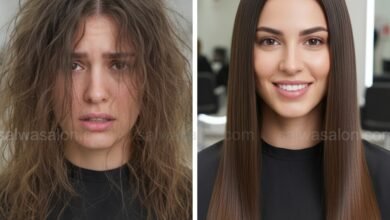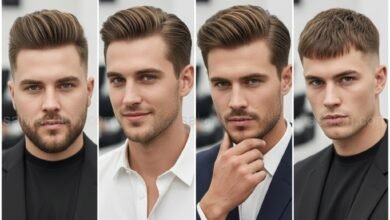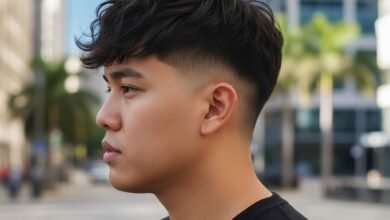Understanding Men's Hair Anatomy, Types, and Care Strategies for Optimal Health

Having healthy, well-groomed hair that reflects one’s persona is every man’s dream. However, men’s hair care is often viewed as a simple routine without a deep understanding of the specific needs of their hair type.
At SalwaSalon.com, we believe that knowledge is the key to achieving optimal hair health. This article will take you beyond the surface, delving into the anatomy of men’s hair, dissecting each hair type with its unique characteristics, and presenting practical, in-depth, science-based care strategies.
Introduction: Why Understanding Men’s Hair Types is Crucial?
Just like fingerprints, every strand of hair has its own characteristics. For men, understanding hair type is not just a trend but the foundation for effective care. Misidentifying hair type often leads to using inappropriate products, triggering various problems ranging from dry and dull hair, oily scalp, to persistent dandruff.
This article will be your essential guide to not only identify your hair type but also understand the ‘why’ behind each characteristic and ‘how’ to care for it optimally.
Men’s Hair Anatomy: The Foundation of Proper Care
Before diving into hair types, let’s understand the basic structure of hair. Each hair strand consists of two main parts: the hair follicle (the root embedded in the scalp) and the hair shaft (the visible part). The shape of the hair follicle is the primary determinant of your hair type. A perfectly round follicle tends to produce straight hair, while an oval or flat follicle will produce wavy or curly hair.
Furthermore, it is also important to understand the layers of the hair shaft:
- Medulla: The innermost core layer (not always present).
- Cortex: The middle layer that determines hair strength, elasticity, and color.
- Cuticle: The outermost layer composed of scale-like cells. A healthy, tightly closed cuticle will make hair appear shiny and protected, while an open cuticle will cause hair to look dull and prone to damage.
Scalp condition also plays a vital role. Sebaceous glands on the scalp produce sebum (natural oil) which moisturizes and protects the hair. Excessive or insufficient sebum production can significantly affect scalp and hair shaft health.
Breaking Down Men’s Hair Types and Their Care Strategies
Each hair type has its unique needs. Let’s discuss them in detail.
Straight Hair: Simple Elegance with Hidden Challenges
Straight hair, common among men of Asian descent, is often considered the easiest to manage. However, its simplicity conceals its own challenges.
Key Characteristics:
- Follicle Shape: Generally round or nearly round, producing straight strands that fall without waves.
- Texture: Hair strands tend to be finer and have tightly closed cuticles, making them appear shiny.
- Sebum Distribution: Natural oil (sebum) from the scalp can easily spread from root to tip due to the straight path. This makes straight hair prone to oiliness, especially on the scalp.
- Volume: Hair volume greatly depends on the thickness of each strand. Thin straight hair will appear flatter, while thick straight hair can look dense.
- Common Problems: Easily greasy due to excess oil, prone to wet dandruff, and hair ends can become dry if cuticles are damaged by excessive exposure.
Optimal Care Strategies:
- Shampoo Frequency: If your scalp tends to be oily, daily shampooing with a formula designed to control oil or deep cleanse can be considered. However, if your scalp is normal or dry, 2-3 times a week is sufficient.
- Shampoo & Conditioner Choice: Choose shampoos labeled “oil control” or “clarifying” for an oily scalp. For the hair shaft, a lightweight conditioner that won’t weigh hair down is ideal. Focus conditioner from mid-lengths to ends, avoiding the roots.
- Heat Protection: Although straight hair appears strong, excessive heat exposure from styling tools or direct sunlight can damage the cuticles. Use heat protectant if you frequently use a hairdryer or straightener.
- Hairstyles: Layered cuts can add volume to thin straight hair. Use lightweight styling products like sea salt spray for texture or water-based pomade for a neat look without feeling heavy.
Wavy Hair: Natural Flexibility with Balanced Needs
Wavy hair is often considered the best combination of straight and curly hair, offering styling flexibility with natural volume.
Key Characteristics:
- Follicle Shape: Follicles tend to be oval, producing soft, loose ‘S’ waves.
- Texture: Can vary from subtle to more defined waves. Generally thicker than straight hair.
- Moisture: Sebum distribution is not as smooth as straight hair, but not as difficult as curly hair, so scalp moisture can generally be well-maintained. However, it remains prone to excess oil at the roots and dryness at the ends.
- Volume: Has good natural volume, giving a full and healthy hair impression.
- Common Problems: Prone to tangles, can experience wet dandruff due to oil and dryness due to uneven moisture.
Optimal Care Strategies:
- Cleansing & Hydration: Use a balancing shampoo and conditioner that cleanses without stripping essential moisture. Ingredients like hyaluronic acid or glycerin can help maintain hydration.
- Tangle Management: Always use a wide-tooth comb or your fingers when hair is wet and conditioner has been applied. Avoid aggressively combing dry wavy hair as it can disrupt the wave pattern and cause frizz.
- Styling Products: Lightweight mousse or cream gel can help define waves without making them stiff. Sea salt spray is also suitable for adding texture.
- Drying: Air dry if possible. If using a hairdryer, use a diffuser on a low heat setting to preserve wave shape and prevent frizz.
Curly Hair: Characteristic Volume That Needs Extra Moisture
Curly hair on men has a denser wave pattern than wavy hair, providing distinctive volume and texture.
Key Characteristics:
- Follicle Shape: More oval than wavy hair, creating tighter waves and sometimes forming loose spirals.
- Texture: Generally thick and has significant natural volume.
- Sebum Distribution: The tighter curl pattern makes it difficult for sebum from the scalp to reach the hair ends, so the hair shaft tends to be dry. However, the scalp can become very oily due to trapped sebum production.
- Common Problems: Frizz (irregularly expanded hair), dryness, easily tangled, and prone to wet dandruff due to scalp oil and dry dandruff due to dehydrated hair shafts.
Optimal Care Strategies:
- Focus on Hydration: Curly hair desperately needs moisture. Use a gentle, sulfate-free shampoo and a rich, moisturizing conditioner. Regularly using a leave-in conditioner or hair mask once a week is highly recommended.
- Shampooing Technique: Don’t shampoo too often; 2-3 times a week is enough. Gently massage the scalp to cleanse without drying it out.
- Detangling: Always comb wet hair with conditioner using your fingers or a wide-tooth comb to avoid damage and pain.
- Styling Products: Curl cream or gel specifically formulated for curly hair will help define curls, reduce frizz, and maintain moisture. Applying products when hair is still wet (after showering) will yield the best results.
- Avoid Tight Ties: Tying hair too often and too tightly can cause breakage and hair loss, as well as increase scalp temperature which triggers sweat and oil.
Coily/Kinky Hair: Unique Texture with Special Care for Strand Integrity
Coily/kinky hair is the hair type with the tightest circular or spiral pattern. Its beauty is unparalleled, but its care requires patience and the right strategy.
Key Characteristics:
- Follicle Shape: The flattest or ribbon-shaped, producing a very tight and distinct spiral pattern.
- Texture: Tends to be thick and dense, providing significant volume. The cuticles on coily/kinky hair often do not completely close, making it prone to moisture loss.
- Sebum Distribution: Due to the very tight spiral pattern, sebum from the scalp is very difficult to spread to the ends of the hair. This makes coily/kinky hair the most prone to dryness. The scalp is also prone to itching due to limited ventilation.
- Common Problems: Extreme dryness, severe frizz, easily tangled to the point of being difficult to detangle, prone to breakage, and scalp problems such as dry dandruff or itching.
Optimal Care Strategies:
- Top Priority: Moisture! This is the main key to coily/kinky hair care. Use a very moisturizing sulfate-free shampoo (co-wash or conditioner-only wash can be an option). Very rich conditioners and deep conditioning treatments (hair masks) at least once a week are crucial.
- Detangling Technique: Only comb hair when wet and after applying conditioner. Use your fingers or an extra-large wide-tooth comb. Start from the ends of the hair, slowly working your way up to the roots.
- Specialized Coily/Kinky Products: Investing in curl activator, curl cream, or butter specifically formulated for coily/kinky hair will help lock in moisture, define the curl pattern, and reduce frizz.
- Drying Technique: Avoid rubbing hair with a towel. Use a microfiber towel or a cotton t-shirt to gently squeeze out excess water. Dry with a diffuser on a low heat setting to preserve the curl pattern and prevent frizz. Do not let hair become too dry.
- Nighttime Protection: Sleep on a satin or silk pillowcase, or use a satin bonnet, to reduce friction and maintain hair moisture.
- Scalp Care: Although the hair shaft is dry, the scalp can still be oily or itchy. Use a gentle anti-dandruff shampoo if needed, but also ensure to maintain the hair shaft’s moisture.
General Principles of Men’s Hair Care for Optimal Health
Regardless of your hair type, some basic principles apply to all:
- Proper Cleansing: Shampooing is the first step. Choose a shampoo according to your hair type and scalp concerns. Gently massage the scalp to improve circulation and lift dirt.
- Conditioner is Important: Conditioner helps to close the cuticles after shampooing, lock in moisture, and make hair more manageable. Apply from mid-lengths to ends, leave for a few minutes, then rinse thoroughly.
- Avoid Excessively Hot Water: Hot water can excessively open hair cuticles, strip natural oils, and dry out hair. Use lukewarm water when shampooing and a final rinse with cool water to close the cuticles.
- Regular Haircuts: Haircuts every 4-6 weeks can eliminate split ends and maintain hair shape and health.
- Nutrition from Within: Healthy hair is also a reflection of a healthy body. Consume foods rich in protein, vitamins (especially Biotin, Vitamin E, D), and minerals (Zinc, Iron) to support strong hair growth.
- Stress Management: Stress can affect the hair growth cycle. Engage in relaxation activities to maintain your mental and physical health.
Choosing the Right Hair Care Products: More Than Just Brands
The hair care product market is vast, but the key is to understand the ingredients within.
- Shampoo: Look for sulfate-free shampoos for dry/wavy/curly/coily hair, or shampoos with oil-controlling agents like salicylic acid or tea tree oil for oily hair.
- Conditioner: Choose one containing emollients like shea butter, coconut oil, or argan oil for intensive hydration, or a lighter one with protein for brittle hair.
- Styling Products:
- Pomade: Water-based for strong hold and easy wash-out, oil-based for very strong hold and shine.
- Gel: Provides strong hold with a stiff finish. Choose alcohol-free to avoid dryness.
- Mousse: To add volume and definition to wavy/curly hair without weighing it down.
- Cream/Lotion: For hydration and frizz control, suitable for curly/coily hair.
- Sea Salt Spray: For natural texture and volume on straight/wavy hair.
We recommend reading product labels and understanding their active ingredients. Do not hesitate to consult an expert at SalwaSalon.com for product recommendations that best suit your hair and scalp profile.
Investing in Knowledge, Investing in Yourself
Understanding your hair type is the first step towards a revolutionary care routine. With in-depth knowledge of your hair’s specific characteristics and needs, you can not only choose the right products and techniques but also address hair problems from their root. Well-maintained hair not only enhances physical appearance but also builds confidence and reflects your attention to detail.






